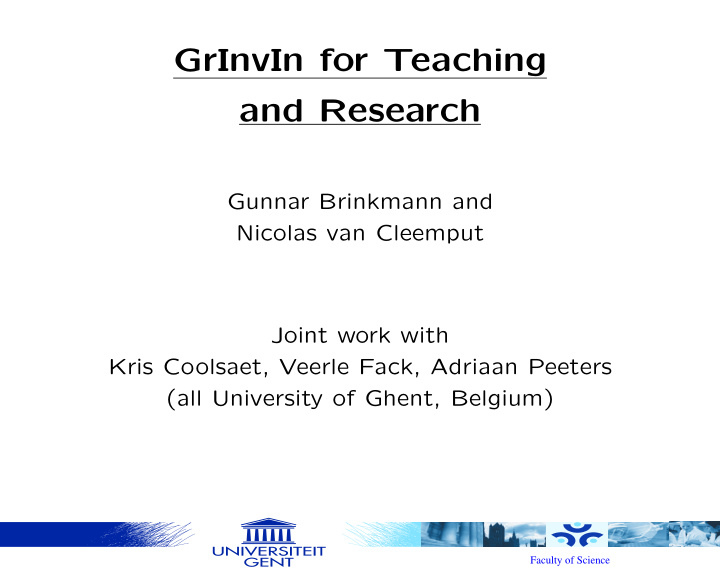



GrInvIn for Teaching and Research Gunnar Brinkmann and Nicolas van Cleemput Joint work with Kris Coolsaet, Veerle Fack, Adriaan Peeters (all University of Ghent, Belgium) Faculty of Science
Motivation: Teaching with Graffiti (S. Fajtlovicz) and Graffiti.pc (E. DeLaVina). Faculty of Science
Faculty of Science
Teaching was done • on university level: USA, Germany, Serbia (Graffiti, Graffiti.pc) Belgium (GrInvIn) • in a course for highschool teachers: Germany (Graffiti.pc), Belgium (GrInvIn, a short introduction) • in some lectures for highschool students: Belgium (GrInvIn) Faculty of Science
Results of the courses: • The approach via trying to prove or dis- prove conjectures is very motivating for students! • Graffiti.pc would need extensive improve- ments before it would be suitable for an educational environment. Faculty of Science
So SOMEONE should develop a software that’s more user friendly and has a better design. . . Jonathan Berry (mathematician, now Sandia, before that he developed LINK while at DIMACS): If you want good and usable mathematical software, a software engineer must be involved at a responsible position! Faculty of Science
Important features for teaching: • easily adapted to various languages – just translate a language file • documentation of invariants Faculty of Science
Important features for teaching: • case sensitive help functions • runs on every platform: unix, gnu/linux, mac, windows Faculty of Science
How can you use it in teaching? Rules: • Choose one fixed invariant and other in- variants to compare it to. e.g.: I want to compare the girth with the diameter, the clique number, the. . . • Put a small graph (e.g. K 3 ) into the list. Faculty of Science
• Then repeat the following steps: – Let the program make a conjecture. – ∗ In case the conjecture is correct: Prove it and afterwards (e.g.) re- move a non-fixed invariant involved from the invariant list. ∗ In case the conjecture is wrong: Give a smallest counterexample, prove minimality and add the counterex- ample to the list. Faculty of Science
Why does it work so well ? • Students identify themselves with their invariant. • It has the flair of discovery. . . • Students see the need to formulate their own lemmas. Faculty of Science
Important Students want to get a normal graph theory course afterwards! Demonstration. Faculty of Science
Ongoing work to support teaching: • Development of an easy handbook for teachers with given scenarios to play safe . • Development of special teaching versions where the teacher’s version has more pos- sibilities than the student’s version. • Making GrInvIn print out a text describ- ing the session (conjectures made, graphs inputted, etc). Faculty of Science
Ongoing work to support teaching: • Improving the conjecturing engine – especially for teaching. • Restriction to given classes (e.g. only planar graphs, only cubic graphs). Faculty of Science
Important features for research: • documentation of how invariants were tested • easy extensibility Demonstration Faculty of Science
Ongoing work to support research: • Make a database of interesting graphs – that is graphs that already served as counterexamples. • Include graph generation programs and counterexample finding programs. • Automatic improvement of conjectures using these routines. • etc.. . . Faculty of Science
A first version is available at grinvin.org Faculty of Science
It would be great if you • would test it. • use it in teaching (maybe with the next version of the conjecturing engine). • mail us about problems, suggestions, ideas, etc. That’s not lost work – GrInvIn is continuously improved! Faculty of Science
It would be great if you • give a course for highschool teachers in your area and try to convince them that graph theory is ideal for teaching mathematical and logical reasoning at highschool level. • were interested in cooperation. . . Faculty of Science
Recommend
More recommend